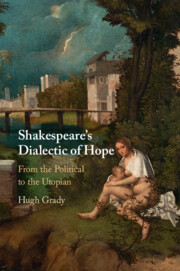Book contents
- Shakespeare’s Dialectic of Hope
- Shakespeare’s Dialectic of Hope
- Copyright page
- Dedication
- Contents
- Acknowledgments
- Part I
- Part II
- Introduction to Part II Shakespeare and the Aesthetic-Utopian
- Chapter 4 From the Political to the Aesthetic-Utopian in Antony and Cleopatra
- Chapter 5 Tyranny, Imagination, and the Aesthetic-Utopian in The Winter’s Tale
- Chapter 6 The Political, the Aesthetic, and the Utopian in The Tempest
- Bibliography
- Index
Chapter 6 - The Political, the Aesthetic, and the Utopian in The Tempest
Enchantment in a Disenchanted World
from Part II
Published online by Cambridge University Press: 02 June 2022
- Shakespeare’s Dialectic of Hope
- Shakespeare’s Dialectic of Hope
- Copyright page
- Dedication
- Contents
- Acknowledgments
- Part I
- Part II
- Introduction to Part II Shakespeare and the Aesthetic-Utopian
- Chapter 4 From the Political to the Aesthetic-Utopian in Antony and Cleopatra
- Chapter 5 Tyranny, Imagination, and the Aesthetic-Utopian in The Winter’s Tale
- Chapter 6 The Political, the Aesthetic, and the Utopian in The Tempest
- Bibliography
- Index
Summary
Chapter 6 shows The Tempest dispersing instances of the aesthetic-utopian and instrumental political power throughout until a remarkable ending imposes a tragicomic aesthetic over all other materials in the play. In describing the disenchanted early modern world with fantasies of enchantment, in representing instrumental reason as magical manipulation of natural spirits, and in manifesting the power of aesthetic representations to heal, restore, and regenerate a fallen humanity, the play is one of Shakespeare’s consummate examples of the aesthetic-utopian. At the center of the play is the master–slave pair Prospero and Caliban. Each is a deposed sovereign in a narrative of betrayal, forming the center of two (fragmentary) dramas that are each an essential part of the larger play. And in the play’s implied after-time, both are restored to their former polities as sovereigns. And both see something of the foolishness of the political struggles in which they had lived so long. As such, they are important parts of the aesthetic-utopian in the play’s conclusion, which does not so much defeat the political as declare it irrelevant to the play’s ultimate aesthetic-utopian vision.
- Type
- Chapter
- Information
- Shakespeare's Dialectic of HopeFrom the Political to the Utopian, pp. 193 - 230Publisher: Cambridge University PressPrint publication year: 2022

